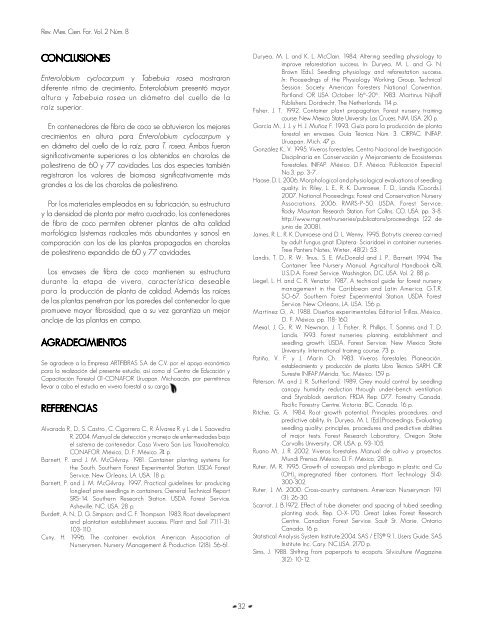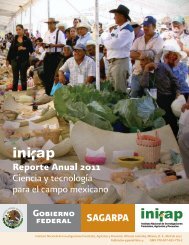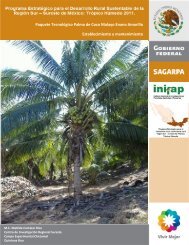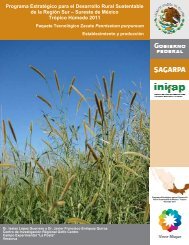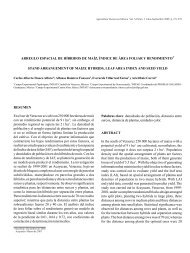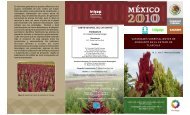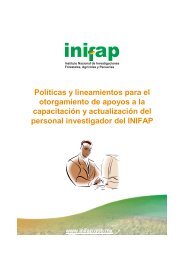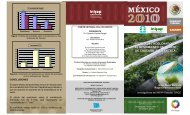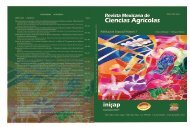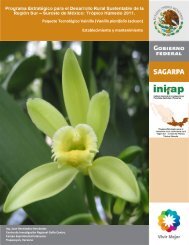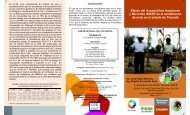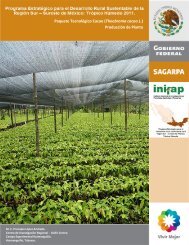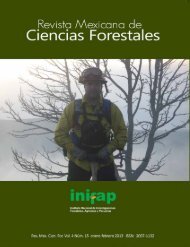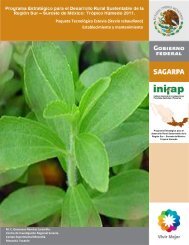Vol. 2 Núm. 8 - Instituto Nacional de Investigaciones Forestales ...
Vol. 2 Núm. 8 - Instituto Nacional de Investigaciones Forestales ...
Vol. 2 Núm. 8 - Instituto Nacional de Investigaciones Forestales ...
- No tags were found...
Create successful ePaper yourself
Turn your PDF publications into a flip-book with our unique Google optimized e-Paper software.
Rev. Mex. Cien. For. <strong>Vol</strong>. 2 Núm. 8CONCLUSIONESEnterolobium cyclocarpum y Tabebuia rosea mostrarondiferente ritmo <strong>de</strong> crecimiento, Enterolobium presentó mayoraltura y Tabebuia rosea un diámetro <strong>de</strong>l cuello <strong>de</strong> laraíz superior.En contenedores <strong>de</strong> fibra <strong>de</strong> coco se obtuvieron los mejorescrecimientos en altura para Enterolobium cyclocarpum yen diámetro <strong>de</strong>l cuello <strong>de</strong> la raíz, para T. rosea. Ambos fueronsignificativamente superiores a los obtenidos en charolas <strong>de</strong>poliestireno <strong>de</strong> 60 y 77 cavida<strong>de</strong>s. Las dos especies tambiénregistraron los valores <strong>de</strong> biomasa significativamente másgran<strong>de</strong>s a los <strong>de</strong> las charolas <strong>de</strong> poliestireno.Por los materiales empleados en su fabricación, su estructuray la <strong>de</strong>nsidad <strong>de</strong> planta por metro cuadrado, los contenedores<strong>de</strong> fibra <strong>de</strong> coco permiten obtener plantas <strong>de</strong> alta calidadmorfológica (sistemas radicales más abundantes y sanos) encomparación con los <strong>de</strong> las plantas propagadas en charolas<strong>de</strong> poliestireno expandido <strong>de</strong> 60 y 77 cavida<strong>de</strong>s.Los envases <strong>de</strong> fibra <strong>de</strong> coco mantienen su estructuradurante la etapa <strong>de</strong> vivero, característica <strong>de</strong>seablepara la producción <strong>de</strong> planta <strong>de</strong> calidad. A<strong>de</strong>más las raíces<strong>de</strong> las plantas penetran por las pare<strong>de</strong>s <strong>de</strong>l contenedor lo quepromueve mayor fibrosidad, que a su vez garantiza un mejoranclaje <strong>de</strong> las plantas en campo.AGRADECIMIENTOSSe agra<strong>de</strong>ce a la Empresa ARTIFIBRAS S.A <strong>de</strong> C.V. por el apoyo económicopara la realización <strong>de</strong>l presente estudio, así como al Centro <strong>de</strong> Educación yCapacitación Forestal 01-CONAFOR Uruapan, Michoacán, por permitirnosllevar a cabo el estudio en vivero forestal a su cargo.REFERENCIASAlvarado R., D., S. Castro., C. Cigarrero C., R. Álvarez R. y L. <strong>de</strong> L. SaavedraR. 2004. Manual <strong>de</strong> <strong>de</strong>tección y manejo <strong>de</strong> enfermeda<strong>de</strong>s bajoel sistema <strong>de</strong> contenedor. Caso Vivero San Luis Tlaxialtemalco.CONAFOR. México, D. F. México. 74 p.Barnett, P. and J. M. McGilvray. 1981. Container planting systems forthe South. Southern Forest Experimental Station. USDA ForestService. New Orleans, LA. USA. 18 p.Barnett, P. and J. M. McGilvray. 1997. Practical gui<strong>de</strong>lines for producinglongleaf pine seedlings in containers. General Technical ReportSRS-14. Southern Research Station. USDA Forest Service.Asheville, NC. USA. 28 p.Bur<strong>de</strong>tt, A. N., D. G. Simpson; and C. F. Thompson. 1983. Root <strong>de</strong>velopmentand plantation establishment success. Plant and Soil 71(1-3):103-110.Cuny, H. 1996. The container evolution. American Association ofNurserymen. Nursery Management & Production 12(8): 56-61.Duryea, M. L. and K. L. McClain. 1984. Altering seedling physiology toimprove reforestation success. In: Duryea, M. L. and G. N.Brown (Eds.). Seedling physiology and reforestation success.In: Proceedings of the Physiology Working Group, TechnicalSession: Society American Foresters National Convention,Portland. OR USA October 16 th -20 th , 1983. Martinus NijhoffPublishers. Dordrecht, The Netherlands. 114 p.Fisher, J. T. 1992. Container plant propagation. Forest nursery trainingcourse. New Mexico State University. Las Cruces, NM. USA. 210 p.García M., J. J. y H. J. Muñoz F. 1993. Guía para la producción <strong>de</strong> plantaforestal en envases. Guía Técnica Núm. 3. CIRPAC. INIFAP.Uruapan, Mich. 47 p.González K., V. 1995. Viveros forestales. Centro <strong>Nacional</strong> <strong>de</strong> InvestigaciónDisciplinaria en Conservación y Mejoramiento <strong>de</strong> Ecosistemas<strong>Forestales</strong>. INIFAP. México, D.F. México. Publicación EspecialNo.3. pp. 3-7.Haase, D. L. 2006. Morphological and physiological evaluations of seedlingquality. In: Riley, L. E., R. K. Dumroese, T. D., Landis (Coords.).2007. National Proceedings: Forest and Conservation NurseryAssociations. 2006. RMRS-P-50. USDA, Forest Service.Rocky Mountain Research Station. Fort Collins, CO. USA. pp: 3-8.http://www.rngr.net/nurseries/publicatons/proceedings (22 <strong>de</strong>junio <strong>de</strong> 2008).James, R. L., R. K. Dumroese and D. L. Wenny. 1995. Botrytis cinerea carriedby adult fungus gnat (Diptera: Sciaridae) in container nurseries.Tree Panters Notes, Winter, 48(2): 53.Landis, T. D., R. W; Tinus., S. E. McDonald and J. P., Barnett. 1994. TheContainer Tree Nursery Manual. Agricultural Handbook 674.U.S.D.A. Forest Service. Washington, DC. USA. <strong>Vol</strong>. 2. 88 p.Liegel, L. H. and C. R. Venator. 1987. A technical gui<strong>de</strong> for forest nurserymanagement in the Caribbean and Latin America. G.T.R.SO-67. Southern Forest Experimental Station. USDA ForestService. New Orleans, LA. USA. 156 p.Martínez G., A. 1988. Diseños experimentales. Editorial Trillas. México,D. F. México. pp. 118-160.Mexal, J. G., R. W. Newman, J. T. Fisher, R. Phillips, T. Sammis and T. D.Landis. 1993. Forest nurseries: planning, establishment andseedling growth. USDA, Forest Service, New Mexico StateUniversity. International training course. 73 p.Patiño, V. F. y J. Marín Ch. 1983. Viveros forestales. Planeación,establecimiento y producción <strong>de</strong> planta. Libro Técnico. SARH. CIRSureste INIFAP.Mérida, Yuc. México. 159 p.Peterson, M. and J. R. Sutherland. 1989. Grey mould control by seedlingcanopy humidity reduction through un<strong>de</strong>r-bench ventilationand Styroblock aeration. FRDA Rep. 077. Forestry Canada,Pacific Forestry Centre. Victoria, BC. Canada. 16 p.Ritchie, G. A. 1984. Root growth potential. Principles procedures, andpredictive ability. In: Duryea, M. L. (Ed.).Proceedings. Evaluatingseedling quality: principles, procedures and predictive abilitiesof major tests. Forest Research Laboratory, Oregon StateCorvallis University, OR. USA. p. 93-105.Ruano M., J. R. 2002. Viveros forestales. Manual <strong>de</strong> cultivo y proyectos.Mundi Prensa. México, D. F. México, 281 p.Ruter, M. R. 1995. Growth of coreopsis and plumbago in plastic and Cu(OH) 2impregnated fiber containers. Hort Technology 5(4):300-302.Ruter, J. M. 2000. Cross-country containers. American Nurseryman 191(3): 26-30.Scarrat, J. B.1972. Effect of tube diameter and spacing of tubed seedlingplanting stock. Rep. O-X-170. Great Lakes Forest ResearchCentre. Canadian Forest Service. Sault St. Marie, OntarioCanada. 16 p.Statistical Analysis System Institute.2004. SAS / ETS ® 9.1. Users Gui<strong>de</strong>. SASInstitute Inc. Cary. NC.USA. 2170 p.Sims, J. 1988. Shifting from paperpots to ecopots. Silviculture Magazine3(2): 10-12.32


